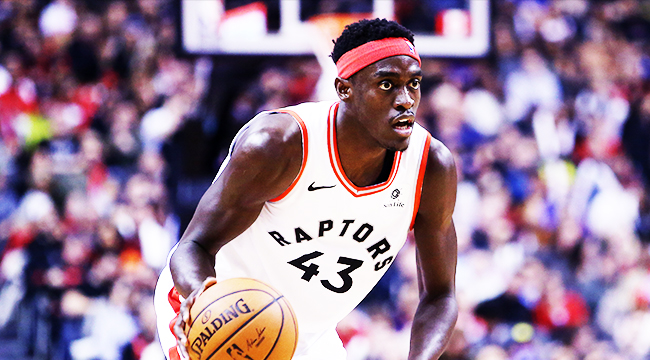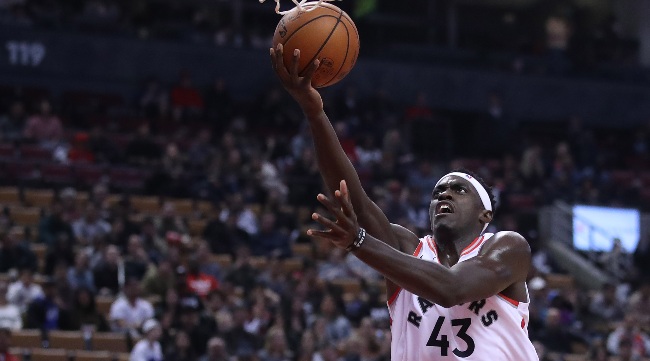
Say it with me: The Toronto Raptors are terrifying.
On Thursday night, the Raptors impressed Drake (and everyone else, but mostly Drake) with a 131-128 overtime victory over the reigning champion Golden State Warriors. It may be a bit much to call the win a statement — those don’t really happen in November, especially against a team missing DeMarcus Cousins, Steph Curry, and Draymond Green. Even with that caveat, surviving a 2K-esque flamethrowing exhibition from Kevin Durant (51 points, 11 rebounds, 6 assists) and 43 combined points from Klay Thompson and Jonas Jerebko fits snuggly in the “Ah, not bad!” folder.
We’re a little past the quarter mark of the regular season and the Raptors have quite the résumé. They have the league’s best record (19-4) despite Kawhi leonard missing six games already. They’re one of five teams that rank in the top 10 in offensive and defensive rating. They rank third in true shooting percentage and first in field goal percentage. If Kawhi (34.2 percent) and Serge Ibaka (29.4 percent) weren’t shooting well below their career marks from three, Toronto would easily be the most efficient team in the league right now.
Ignoring the numbers for a minute, the Raptors just look dangerous. This is a long, athletic, and smart group that can carve you up in a multitude of ways. First-year head coach Nick Nurse has seemingly pushed all the right buttons so far, mixing and matching countless lineup combinations. The versatility of this team is what makes them the biggest threat to the Warriors right now. You can obviously thank Kawhi for that, because he’s the tip of the spear.

However, the team’s trump card may be Pascal Siakam, a 6’9 chameleon that has been throwing opposing teams for a loop all season long. We’ll get to his defense in a bit — he’s a nightmare on that end of the floor — but the reason Siakam is a Most Improved Player candidate is his pick-your-poison impact on the Raptors’ offense.
In general, teams look to overwhelm you with size, shooting, or speed. Good teams can do so with two of those traits. The elite ones, like the Warriors and Raptors, can do all three.
The Raptors can’t do that as well, if at all, without Siakam. Equipped with a 7’3 wingspan, soft hands, nimble feet, and crazy hops, Siakam can serve as an effective rim-runner. You can put emphasis on “runner” because there aren’t many bigs in the league that can keep up with him when he turns on the jets.
At the beginning of that clip, he and Andre Iguodala are pretty level. Once Leonard gains control of the ball, Iguodala actually starts running first in an effort to get back, but then Siakam goes hyperspeed to fill the lane. By the time Siakam reaches half-court, Iguodala is signaling for help because he knows he can’t catch him. When your “big” can outrun a guard/forward that dramatically, it becomes easy to understand why other bigs can’t keep up.
Siakam is generating 1.36 points per transition possession, placing him in the 86th percentile league-wide. He’s shooting a blistering 78.2 percent in transition, by far the best mark among the 67 players that have logged at least 50 transition possessions. Giannis Antetokounmpo (66.7 percent) is a distant second.
On top of being able to fly in transition, he can also create for himself in the half court. Though the volume is low so far this season, Siakam has been a terror in isolation (1.38 points per possession, 98th percentile), pick-and-rolls (1.29 points per possession, 99th percentile), and on the block (1.19 points per possession, 95th percentile).
He’s been given more freedom to showcase his ball skills. Against smaller opponents, he’s been able to bully his way inside before sprinkling in an improved jump hook. Against bigs, he’s getting to the basket with an array of hesitation dribbles and a nasty, quick-twitch spin move.
As is the case in transition, bigs have really struggled to keep Siakam in front of them. Don’t take my word for it, though, just ask Jerebko.
The swing skill for Siakam is still his jumper. He shot 22 percent from deep last season, but that never stopped him from taking them when he was open. Those reps, and that confidence, has started to pay off. After his 3-for-4 showing against the Warriors on Thursday, he’s now shooting 36.6 percent from deep on 1.8 attempts per game.
That’s hardly volume on par with the Currys and Thompsons of the world, but it’s important. Teams know he’ll take open threes if they’re presented to him, and if he keeps making them at a decent clip, that forces opponents to start closing out. That will further open up his driving game, and depending on the personnel he faces, that should open up a whole can of worms for opponents.
Toronto has scored over 117 points per 100 possessions with Siakam on the court this season. He has spent a large chunk of his minutes (417 of 684 to be exact) with Leonard and Kyle Lowry, so that helps, but he’s proven to be an important piece to that trio as well. When those three are on the court together, the Raptors have scored 119.5 points per 100 possessions. When the two stars are on the floor without Siakam, the offensive rating drops to 110.9 — a very good mark, but not an historic one.
The calling card for Siakam, though, is his defensive malleability. Let’s start here.
That is Siakam guarding Kevin freakin’ Durant 45 feet from the basket. Durant receives a high screen that temporarily washes Siakam out of the play. He thinks he’s about to waltz into a pull-up three, but … nope!
Siakam’s motor never stops, and that helps him when he finds himself on the perimeter against wings and guards. He’s one of the rare players in the league that can legitimately defend all five positions in a pinch. He moves his feet incredibly well for a guy his size, and clearly has the length to disrupt shots at the rim.
The defensive end is where Siakam’s versatility really helps Toronto. They can go “small” with him at the 5, surround him with wings, then just switch everything without worry. But because of Siakam’s comfort defending on the perimeter, they can also slide him up to the 4 and play him alongside Ibaka or Jonas Valanciunas in a more traditional “drop” scheme.
Toronto has allowed 102.6 points per 100 possessions with Siakam on the court. That figure goes up to 107.4 when he’s on the bench. The Raptors have eight different lineups (min. 10 minutes) with a defensive rating under 100. Siakam is in five of those. That isn’t a coincidence.
There are plenty of worthy candidates for this year’s Most Improved Player award. Miami’s Josh Richardson and Sacramento’s De’Aaron Fox (yeah, yeah, second-year player, whatever) have been outstanding in their own right this season. However, right now, it’s hard to imagine anyone other than Siakam taking home the award if he keeps this up. His per-game numbers have certainly taken a jump, but beyond that, he just looks like an entirely different player. A strong argument could be made that he’s already Toronto’s third-best player, and if he jumper proves to be real, Toronto could have a budding star on their hands moving forward.






